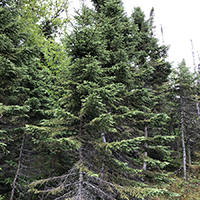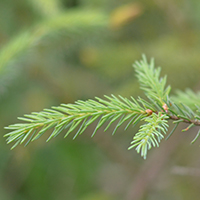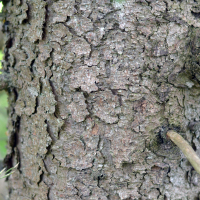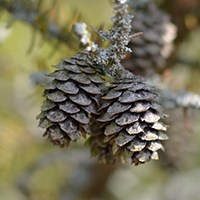What black spruce looks like
Size and shape
- Grows 20 to 30 metres tall.
- Trunk reaches 23 to 26 centimetres in diameter.
Needles
- Short, dark, blueish-green needles with blunt ends.
Bark
- Thin, scaly grey-brown bark.
Fruit
- Egg-shaped dark brown cones (2 to 3 centimetres long).
- Located at the top of the tree and may stay on the tree for up to 30 years.
Where black spruce is found
Black spruce is a transcontinental species, as it grows across Canada and throughout Ontario.
What you need to know to grow black spruce
- Moisture: tolerates many moisture levels.
- Shade: tolerates partial shade.
- Soil: grows in a variety of soils.
- Note: black spruce will grow taller and thicker on high, dry ground. Black spruce trees grown in wetlands will be much smaller but can still live for 200 years. Black spruce may be susceptible to spruce budworm damage during severe outbreaks.
Benefits and uses of black spruce
Wildlife benefits
Black spruce trees provide food and habitat for several bird and small mammal species. For example:
- small mammals and birds, such as squirrels and chickadees, eat seeds from black spruce cones
- snowshoe hares and occasionally moose browse black spruce
- black spruce trees provide cooling cover for mammals such as moose in the summer
- songbirds such as warblers nest in black spruce trees
Commercial uses
Black spruce is one of Ontario’s main species for pulp and paper production. Black spruce wood is also used for lumber. Young trees are harvested for Christmas trees.
Current research
To learn about our research on black spruce, visit our science publications catalogue and search for “black spruce.”
Fun facts about black spruce
- Black spruce is one of the only species that can grow in shallow soil above permafrost in northern habitats.
- As permafrost melts, black spruce and other northern trees can tip over — this phenomenon is called drunken trees.
Updated: January 10, 2024
Published: July 18, 2014



